Catching z’s in Zanzibar
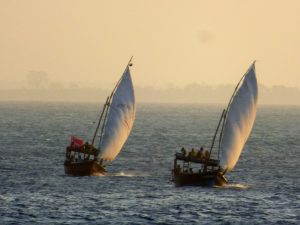
Jennifer and I have wanted to come to Zanzibar for years. We don’t even really know why. It was probably in some book we read, and it captured our imagination as exotic and outlandish. So that’s why we’re here – because it’s Zanzibar and we’ve wanted to come here for literally decades.
Getting here was a bit of a schlep. Sydney to Doha in 14 hours, then six hours back to the south to end up in a small, boiling hot shack of an airport where the customs people laboriously copied out by hand the information written in our passports while, in a moment of dissonance, attaching it somehow to electronically captured photos and fingerprints.
The first thing that struck us was the heat. It is properly hot – it’s somewhere in the thirties and that’s pretty much where it sits all year round.
We tracked down our driver waiting behind a security cordon about 50m from the airport entrance and breathed a sigh of relief as we got into an air-conditioned van. The boys pretty much instantly fell asleep, which was a shame because it’s an interesting drive up to the North of the island. Zanzibar is actually an archipelago made up of many islands, although the name generally attaches to the main island. The airport is near the South and the place we are staying is on the Northern tip; that’s about an hour’s drive.
The roads were good, well at least okay, but certainly better than in Burma; and thanks to a bit of British history they drive on the left. Like in many third-world countries the roads are lined with houses and people seem to live much of their lives out in the open – which is disconcerting from the luxury of an air-conditioned van, but certainly gives an insight into how people live. One thing that was immediately noticeable was that being an almost entirely Muslim country means that everyone is very conservatively dressed, and that looks really hot in tropical Africa.
Tanzania is very poor. The average annual earnings amount to something like $250 and most of the country lives below the poverty line. Infant mortality is troublingly high and life-expectancy is not good. Zanzibar is worse than the rest of the country – the place subsists on cultivating spices and, of course, tourism. In it’s heyday, Zanzibar was wildly rich, for some, on the back of the slave trade.
It took about an hour to get to Nungwi which is a strip of beautiful white sand bordering the Indian Ocean. Our hotel, the Z Hotel, is one of several fronting the beach and filled with a range of tanned Scandinavians.
(The letter Z crops up all over the place here, for obvious reasons. There’s something interesting in contrasting it with another island we’ve visited – Iceland which voted to abolish the letter Z in 1973.)
We all felt much better after a swim, and then a meal while watching the lateen-rigged dhows silhouetted against the setting sun.
For our first full day in Zanzibar we did pretty much as planned and have lazed about swimming and eating and trying to dodge jet-lag. The ocean is beautifully warm to swim in and the fine, white sand makes the shallows a wonderful, almost glowing, green colour. The colour fades to a deep blue out towards the horizon where the sea is dotted with the white and grey sails of the local fishermen slipping between the distant islands.
It really is idyllic and a great way to get over the flight. But it’s making us even more excited at the prospect of the upcoming safari.
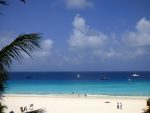
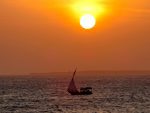
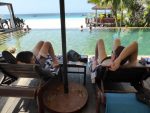
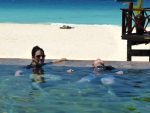
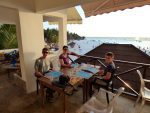
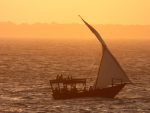
Hi, as it happens my dream too was to visit
Zanzibar once, no logical explanation. All looks great..Callum in the photo looks so tall
Keep having fun